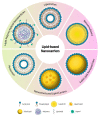Pulmonary Delivery of Anticancer Drugs via Lipid-Based Nanocarriers for the Treatment of Lung Cancer: An Update
- PMID: 34451824
- PMCID: PMC8400724
- DOI: 10.3390/ph14080725
Pulmonary Delivery of Anticancer Drugs via Lipid-Based Nanocarriers for the Treatment of Lung Cancer: An Update
Abstract
Lung cancer (LC) is the leading cause of cancer-related deaths, responsible for approximately 18.4% of all cancer mortalities in both sexes combined. The use of systemic therapeutics remains one of the primary treatments for LC. However, the therapeutic efficacy of these agents is limited due to their associated severe adverse effects, systemic toxicity and poor selectivity. In contrast, pulmonary delivery of anticancer drugs can provide many advantages over conventional routes. The inhalation route allows the direct delivery of chemotherapeutic agents to the target LC cells with high local concertation that may enhance the antitumor activity and lead to lower dosing and fewer systemic toxicities. Nevertheless, this route faces by many physiological barriers and technological challenges that may significantly affect the lung deposition, retention, and efficacy of anticancer drugs. The use of lipid-based nanocarriers could potentially overcome these problems owing to their unique characteristics, such as the ability to entrap drugs with various physicochemical properties, and their enhanced permeability and retention (EPR) effect for passive targeting. Besides, they can be functionalized with different targeting moieties for active targeting. This article highlights the physiological, physicochemical, and technological considerations for efficient inhalable anticancer delivery using lipid-based nanocarriers and their cutting-edge role in LC treatment.
Keywords: aerosols; dry powder inhalers; lipid-based nanocarriers; liposomes; lung cancer; nanoemulsions; nanotechnology; pulmonary delivery; targeted drug delivery.
Conflict of interest statement
The authors declare no conflict of interest. The funders had no role in the design of the study; in the collection, analyses, or interpretation of data; in the writing of the manuscript, or in the decision to publish the results.
Figures


Similar articles
-
Inhalable Formulations to Treat Non-Small Cell Lung Cancer (NSCLC): Recent Therapies and Developments.Pharmaceutics. 2022 Dec 31;15(1):139. doi: 10.3390/pharmaceutics15010139. Pharmaceutics. 2022. PMID: 36678768 Free PMC article. Review.
-
Nanotechnology-Assisted Metered-Dose Inhalers (MDIs) for High-Performance Pulmonary Drug Delivery Applications.Pharm Res. 2022 Nov;39(11):2831-2855. doi: 10.1007/s11095-022-03286-y. Epub 2022 May 12. Pharm Res. 2022. PMID: 35552983 Free PMC article. Review.
-
The Role of Inhaled Chitosan-Based Nanoparticles in Lung Cancer Therapy.Pharmaceutics. 2024 Jul 23;16(8):969. doi: 10.3390/pharmaceutics16080969. Pharmaceutics. 2024. PMID: 39204314 Free PMC article. Review.
-
Inhalable PEGylated Phospholipid Nanocarriers and PEGylated Therapeutics for Respiratory Delivery as Aerosolized Colloidal Dispersions and Dry Powder Inhalers.Pharmaceutics. 2014 Jun 20;6(2):333-53. doi: 10.3390/pharmaceutics6020333. Pharmaceutics. 2014. PMID: 24955820 Free PMC article.
-
Formulation and clinical perspectives of inhalation-based nanocarrier delivery: a new archetype in lung cancer treatment.Ther Deliv. 2021 May;12(5):397-418. doi: 10.4155/tde-2020-0101. Epub 2021 Apr 27. Ther Deliv. 2021. PMID: 33902294 Review.
Cited by
-
Microfluidics as a promising technology for personalized medicine.Bioimpacts. 2024 Jun 16;15:29944. doi: 10.34172/bi.29944. eCollection 2025. Bioimpacts. 2024. PMID: 39963565 Free PMC article. Review.
-
Targeted delivery of bee venom to A549 lung cancer cells by PEGylate liposomal formulation: an apoptotic investigation.Sci Rep. 2024 Jul 27;14(1):17302. doi: 10.1038/s41598-024-68156-6. Sci Rep. 2024. PMID: 39068207 Free PMC article.
-
Nanoemulsions: Formulation, characterization, biological fate, and potential role against COVID-19 and other viral outbreaks.Colloid Interface Sci Commun. 2021 Nov;45:100533. doi: 10.1016/j.colcom.2021.100533. Epub 2021 Oct 20. Colloid Interface Sci Commun. 2021. PMID: 34692429 Free PMC article. Review.
-
Uncovering the Emerging Prospects of Lipid-based Nanoparticulate Vehicles in Lung Cancer Management: A Recent Perspective.Pharm Nanotechnol. 2025;13(1):155-170. doi: 10.2174/0122117385286781240228060152. Pharm Nanotechnol. 2025. PMID: 38468532 Review.
-
Liposomes or Extracellular Vesicles: A Comprehensive Comparison of Both Lipid Bilayer Vesicles for Pulmonary Drug Delivery.Polymers (Basel). 2023 Jan 7;15(2):318. doi: 10.3390/polym15020318. Polymers (Basel). 2023. PMID: 36679199 Free PMC article. Review.
References
-
- World Health Organization The Global Cancer Observatory. Cancer Fact Sheets. [(accessed on 23 April 2021)]; Available online: http://gco.iarc.fr/today/data/factsheets/cancers/15-Lung-fact-sheet.pdf.
-
- American Cancer Society Key Statistics for Lung Cancer. [(accessed on 23 April 2021)]; Available online: https://www.cancer.org/content/cancer/en/cancer/lung-cancer/about/key-st....
-
- National Cancer Institute The Surveillance, Epidemiology, and End Results (SEER) Program. Cancer Stat Facts: Lung and Bronchus Cancer. [(accessed on 23 April 2021)]; Available online: https://seer.cancer.gov/statfacts/html/lungb.html.
-
- World Health Organization International Agency for Research on Cancer. The Global Cancer Observatory (GCO). Cancer Tomorrow (Incidence) [(accessed on 23 April 2021)]; Available online: http://gco.iarc.fr/tomorrow/graphic-line?type=0&population=900&mode=popu....
Publication types
Grants and funding
LinkOut - more resources
Full Text Sources

